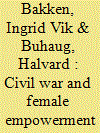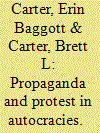|
|
|
Sort Order |
|
|
|
Items / Page
|
|
|
|
|
|
|
| Srl | Item |
| 1 |
ID:
178671


|
|
|
|
|
| Summary/Abstract |
Recent research has directed attention to the transformative potential of war for female empowerment. As a disruptive shock, armed conflict can create a window of opportunity for advancing the societal role of women. We complement this research agenda by looking at how conflict severity and termination condition the outcomes for women in the aftermath of civil conflict. We expect that both level of violence and mode of resolution affect subsequent female empowerment, where severe conflicts ending by a negotiated settlement have the greatest transformative potential. Consistent with expectations, we find that post-conflict improvements in female empowerment occur primarily after high-intensity civil conflicts. However, subsequent tests reveal that this effect is driven largely by conflicts terminated by peace agreements. The greatest improvement in female empowerment is seen when peace agreements have gender-specific provisions. These results support calls for a sustained effort toward mainstreaming gender issues in conflict resolution and peacebuilding processes.
|
|
|
|
|
|
|
|
|
|
|
|
|
|
|
|
| 2 |
ID:
178675


|
|
|
|
|
| Summary/Abstract |
A wealth of literature argues that domestic institutions can sometimes restrain government repression. In this article, we highlight an institution tasked specifically with protecting and promoting human rights: the National Human Rights Institution (NHRI). Although common international standards exist, NHRIs exhibit substantial variation in their organization, the rights that they protect, the activities they permit, and the manner in which they appoint their members. Scholarship to date has conceptualized and measured NHRIs dichotomously; an NHRI either exists or it does not. We present data that highlights NHRI heterogeneity collected via content analysis of NHRI annual reports, NHRI websites, national constitutions, government legislation, and other sources. Using these data, we show NHRIs that can publish their findings and NHRIs that can punish offenders are each associated with less state torture. These data will allow future researchers to better explore important questions regarding NHRI origins, design, processes, and effectiveness.
|
|
|
|
|
|
|
|
|
|
|
|
|
|
|
|
| 3 |
ID:
178662


|
|
|
|
|
| Summary/Abstract |
A number of proposals for reducing tensions with North Korea have discussed alterations to the program of joint military exercises (JMEs) that South Korea holds. North Korea has also repeatedly called for a reduction or secession of JMEs. Would limiting or halting JMEs be a useful concession for securing a reduction of tensions on the peninsula? We argue that JMEs do not deter North Korea but, instead, provoke provocative rhetoric and actions, demonstrating that North Korea views JMEs as a serious threat to its security. In this paper, we establish a relationship between JMEs and North Korea’s actions. In response to a JME, North Korea can issue warnings or threats as well as take costly signals such as conducting missile or nuclear tests. Using new data on JMEs and North Korean behavior, we find that North Korea systematically responds with aggression to South Korean JMEs. Moreover, we find that the intensity of North Korea’s responses to JMEs is driven by the severity of the threat particular exercises pose, indicating that North Korea responds to JMEs as serious security threats.
|
|
|
|
|
|
|
|
|
|
|
|
|
|
|
|
| 4 |
ID:
178664


|
|
|
|
|
| Summary/Abstract |
Why do states join wartime coalitions despite the absence of a salient threat or strong ties to the coalition leader? We argue states make unexpectedly high contributions to coalition warfare as a costly signal of their desire for a stronger relationship with the coalition leader. Conventional theories insufficiently explain why states without immediate security interests or strong ties to the lead state over-contribute relative to their capacity. Using newly compiled data on troop contributions to the war in Afghanistan (2001–2014), we find states are most likely to contribute a higher share of their armed forces when their relationship with the US has unrealized alliance potential. States with under-performing alignments leave substantial room for subsequent gains to be had from signaling their commitment to the leading coalition actor. Our finding helps explain why states risk the costs of war—casualties and domestic accountability—by participating in coalition warfare.
|
|
|
|
|
|
|
|
|
|
|
|
|
|
|
|
| 5 |
ID:
178666


|
|
|
|
|
| Summary/Abstract |
Does propaganda reduce the rate of popular protest in autocracies? To answer this question, we draw on an original dataset of state-run newspapers from thirty countries, encompassing six languages and over four million articles. We find that propaganda diminishes the rate of protest, and that its effects persist over time. By increasing the level of pro-regime propaganda by one standard deviation, autocrats have reduced the odds of protest the following day by 15%. The half-life of this effect is between five and ten days, and very little of the initial effect persists after one month. This temporal persistence is remarkably consistent with campaign advertisements in democracies.
|
|
|
|
|
|
|
|
|
|
|
|
|
|
|
|
| 6 |
ID:
178668


|
|
|
|
|
| Summary/Abstract |
Under what conditions can dictatorships manage peaceful leadership transitions? This article argues that constitutional succession rules are critical for modern dictatorships, contrary to the predominant scholarly focus on hereditary succession or parties. An effective succession rule needs to solve dual problems of peaceful exit and peaceful entry. First, the rule must enable incumbents to exit power peacefully by reducing coup threats. Second, the rule must empower the designated successor to ensure that they can enter power peacefully. Constitutional rules help solve both problems, and are particularly effective when they appoint the vice president as the designated successor. The vice president’s access to material resources deters other factions from challenging the succession procedure, whereas designating successors without a power base is ineffective. Using original data on constitutional rules in African autocracies, I show that regimes that formally designate the vice president as the successor are more likely to undergo peaceful transitions.
|
|
|
|
|
|
|
|
|
|
|
|
|
|
|
|
|
|
|
|
|